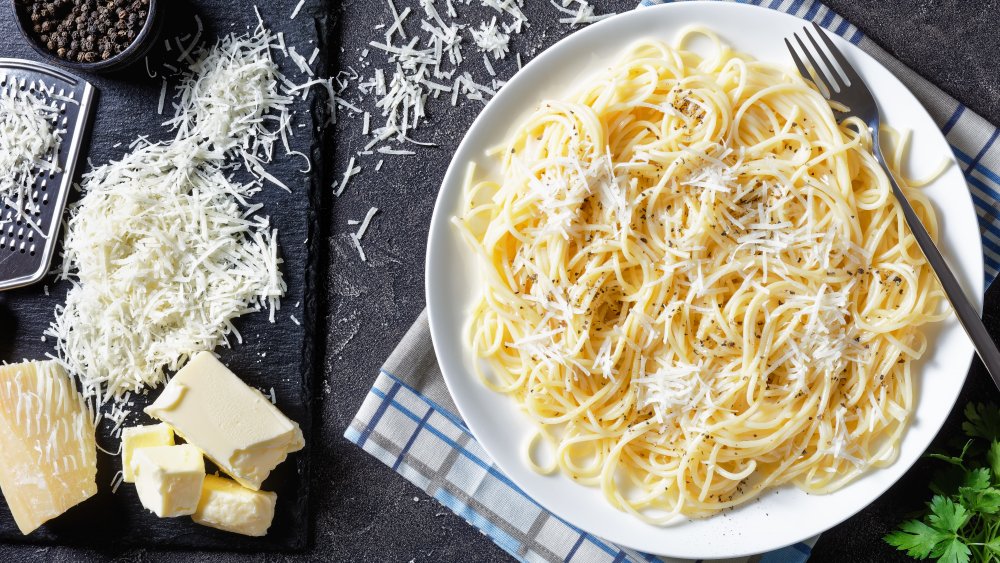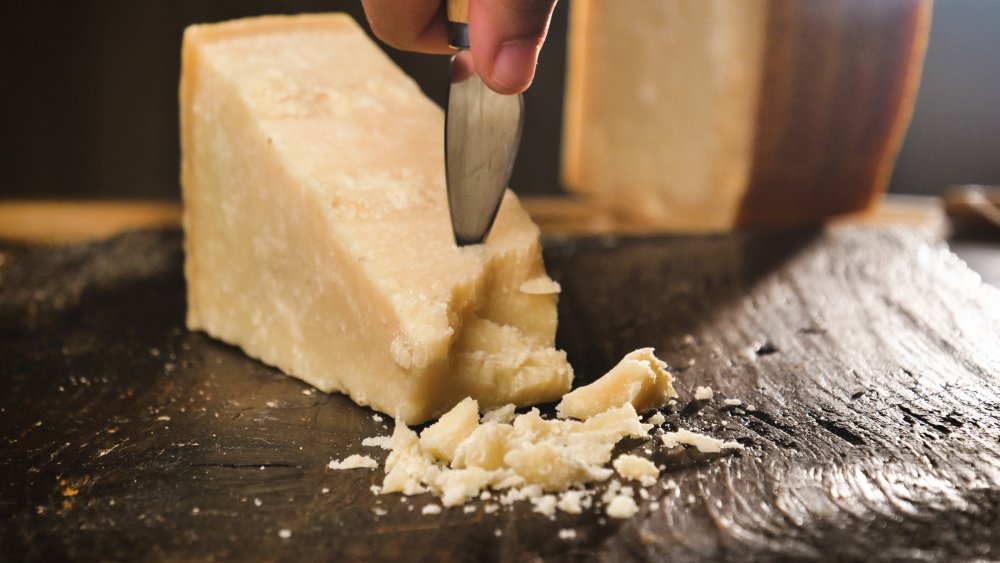Nutritionist Exposes Everything Fake About Parmesan Cheese
As you shower your spaghetti and meatballs with that prized grated cheese, consider this: what you think is Parmesan might be the farthest thing from it.
In the United States, we typically refer to Parmigiano Reggiano cheese as Parmesan, and it's one of the most popular, top-selling cheeses worldwide. In Italy, it's dubbed the "King of Cheeses" for its crumbly texture, tangy sweetness, flavor notes of almonds and strawberries, and an aroma reminiscent of the grassy, Italian pastures where the dairy cows graze (via Murray's Cheese).
There's no doubt, Parmesan is the King of Grating too. Parmigiano Reggiano cheese belongs to the Grana family of cheeses, a collection of hard, mature cheeses from Italy that have a granular, crumbly texture, and are mainly used for grating (via Cheese.com).
True Parmesan is also distinguishable from many other cheeses thanks to its umami-like quality, a characteristic that adds depth of flavor and richness to every shred (via The New Yorker). But don't get too excited, though — unless you're checking labels, you might not catch a whiff of that real umami experience.
Parmesan cheese has rules of its own
In Europe, Parmigiano Reggiano cheese is a Protected Designation of Origin product (PDO), meaning, it can only call itself "Parmigiano Reggiano PDO" if it's produced, processed, and prepared in a specific geographical area (Parma, Reggio-Emilia, Modena, Mantua, and Bologna), using recognized, local producers, and genuine, local, raw milk (via Italian Trade Commission).
If only we were as strict on this side of the pond. There are no regulations in the U.S., so any cheese can call itself Parmesan, regardless of where or how it was made. In fact, our so-called Parmesan doesn't need to contain any real Parmesan at all (via Foodbeast). That's simply not cool.
According to The Parmigiano Reggiano Consortium, "Parmigiano Reggiano is strongly bound to its area of origin, and no other place in the world can produce the same product — even if the same production techniques were used." Someone might want to remind the U.S. Government; according to the FDA's Code of Federal Regulations Title 21, when it comes to grated cheeses, "The name 'reggiano' may be used for 'parmesan'."
Seems a certain cheese manufacturer in Pennsylvania also missed the memo. Despite product labels touting 100 percent Parmesan cheese, consumers were making their Fettuccine Alfredo with Swiss, cheddar, mozzarella, and wood pulp (via Bloomberg). The bigger issue is that people had no idea. The company, Castle Cheese Co., sold the fake cheeses under a variety of brands, to retailers and wholesalers nationwide (via Food Safety News). The good news is, they got caught, pled guilty, served three years of probation, paid fines, and are now defunct (via Inc.com).
You might be eating wood pulp too
Freshly grated Parmesan tends to stick together, so some manufacturers add cellulose, an FDA-approved, wood pulp-based additive used to prevent clumping. And the FDA allows up to 4 percent cellulose in grated Parmesan cheese (via Eater).
But some manufacturers don't stop there. When tested, Walmart's Great Value brand was shown to have 10 percent cellulose in its 100 percent grated Parmesan cheese — another day, another Parmesan lawsuit (via Bloomberg).
So how can you make sure you're getting the real deal? It's pretty easy actually — if you stick to a wedge of cheese, versus the grated/shredded alternative. For authentic Parmigiano Reggiano, get a wedge with a tattoo — there's an unmistakable dotted pattern burned into the rind, and it says (not surprisingly) "Parmigiano Reggiano" (via Today.com).
Too pricey for ya? Parmesan-like cheeses from other regions, including America, can be pretty delicious too, if you choose wisely. For the best texture and flavor, start shopping in the deli department, near the other specialty cheeses. If you can't find what you want, move on to the dairy case and look for domestic wedges there. As a last resort, cruise the aisles. But take note, real cheese is perishable, so your goal should be to find something that requires refrigeration.
When you get home, grate and/or crumble the cheese yourself. If you've been using pre-grated cheese all along, you'll be shocked how much more flavor you get from a freshly-grated wedge.
If you're hard-set on buying grated and pre-shredded Parmesan, choose reputable brands that also sell the real wedges. And again, your best chance of finding shredded and grated Parmesan cheese without cellulose will be in the refrigerated section.
Robin Miller is a nutritionist, chef, and food writer.


